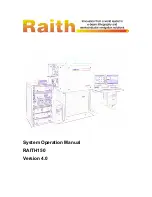
36
Chapter 4 Introduction to Effects and Parameters
AW (Auto Wah)
This changes the filtering over a periodic cycle, providing an
automatic wah effect.
TM (Tone Modify)
This changes the tone of the connected guitar.
GS (Guitar Simulator)
Simulation of the characteristics of particular guitar
components such as pickups and different guitar bodies
allows you to switch among a number of different guitar
types all while using a single guitar.
Frequency
0–100
Adjusts the center frequency of the Wah ef-
fect.
Peak
0–100
Adjusts the way in which the wah effect ap-
plies to the area around the center frequen-
cy.
Higher values will produce a stronger tone which emphasizes the
wah effect more.
With a value of “50” a standard wah sound will be produced.
Direct Level
0–100
Adjusts the volume of the direct sound.
Effect Level
0–100
Adjusts the volume of the effect sound.
Parameter/
Range
Explanation
Mode
LPF, BPF
Selects the wah mode.
LPF (Low Pass Filter)
This creates a wah effect over a wide frequency range.
BPF (Band Pass Filter)
This creates a wah effect in a narrow frequency range.
Frequency
0–100
Adjusts the center frequency of the Wah ef-
fect.
Peak
0 –100
Adjusts the way in which the wah effect ap-
plies to the area around the center frequen-
cy.
Higher values will produce a stronger tone which emphasizes the
wah effect more. With a value of “50” a standard wah sound will be
produced.
Rate
0–100,
BPM
–BPM
Adjusts the frequency of the auto wah.
* When set to BPM, the value of each parameter will be set according to
the value of the Master BPM (p. 51) specified for each patch. This makes
it easier to achieve effect sound settings that match the tempo of the
song (synchronizing the cycle to one-half or one-fourth of the BPM
when the set cycle rate is increased).
When setting to BPM, press PARAMETER [
] several times to
display the Master BPM settings screen.
Depth
0–100
Adjusts the depth of the auto wah effect.
Direct Level
0–100
Adjusts the volume of the direct sound.
Effect Level
0–100
Adjusts the volume of the effect sound.
Parameter/
Range
Explanation
Parameter/
Range
Explanation
Type
see below
Selects the type of tone modification.
Fat
Fat tone with boosted mid range.
Presence
Bright tone with boosted high-mid range.
Mild
Mild tone with the high end cut back.
Tight
Tone with the low frequencies cut.
Enhance
Tone with the high frequencies boosted.
Resonator1, 2, 3
This produces a tone with greater power
and punch by adding resonance in the low-
frequency range and midrange.
Low
-50–+50
Adjusts the tone for the low frequency
range.
High
-50–+50
Adjusts the tone for the High frequency
range
Resonance
0–100
This adjusts the strength of the low-end and
midrange resonance when Type is set to
Resonator 1, 2, or 3.
Level
0–100
Adjusts the volume.
Parameter/
Range
Explanation
Type
see below
Selects the type of the guitar simulator.
‘S’
→
’H’
Changes from a single-coil pickup tone to a
humbucking pickup tone.
‘H’
→
’S’
Changes from a humbucking pickup tone to
a mixed tone of two single-coil pickups.
‘H’
→
’HF’
Changes from a humbucking pickup tone to
a single-coil pickup half tone.
‘S’
→
Hollow
Changes a single-coil pickup tone to a full-
acoustic tone with the body resonance add-
ed.
‘H’
→
Hollow
Changes a humbucking pickup tone to a
full-acoustic tone with the body resonance
added.
‘S’
→
AC
Changes a single-coil pickup tone to an
acoustic guitar tone.
‘H’
→
AC
Changes a humbucking pickup tone to an
acoustic guitar tone.
‘P’
→
AC
Changes a piezo pickup tone to an acoustic
guitar tone.
GT-8_e.book 36 ページ 2007年6月29日 金曜日 午後3時55分
















































